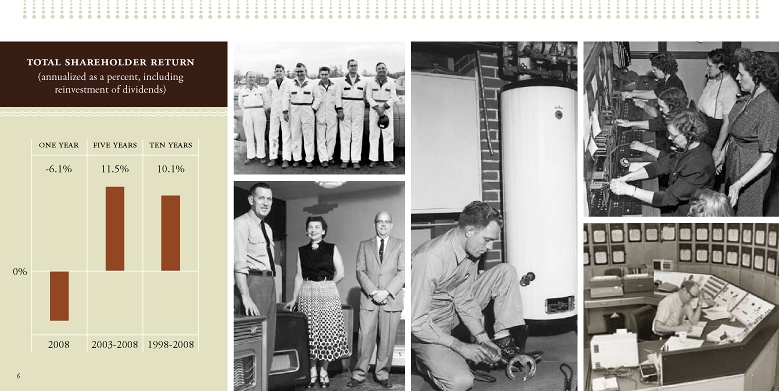
regulators to revise our 20-year-old gas cost-sharing mechanism to better balance the risks and rewards between customers and shareholders. In the past, we returned two-thirds of any money saved on gas cost purchases to customers, while shareholders kept one-third of the savings. If gas costs were higher than forecasted in our rates, shareholders absorbed one third of any losses.
The new agreement reached with the OPUC allows us to annually select either a 90/10 or 80/20 customer shareholder split. This gives us added flexibility in managing gas costs.
In March 2008, NW Natural filed for a general rate case in Washington, where approximately 10 percent of our customer base is located. Under the Washington Utilities and Transportation Commission (WUTC) final order, NW Natural’s revenue requirements increase by approximately $2.7 million a year. NW Natural’s authorized return on equity is 10.1 percent,
and its authorized rate of return is 8.4 percent. Overall, we believe this represents a fair outcome for the company and its customers. The new rates took effect January 1, 2009.
expanding the playing field
NW Natural’s founders, Leonard and Green, never allowed geography to limit their aspirations. They moved from the East Coast to Astoria, where the Columbia River meets the Pacific Ocean. They then relocated to Portland where they foresaw greater opportunity.
While NW Natural is proud of its Northwest roots, we are also looking for growth beyond our traditional boundaries. In 2008, we advanced storage and pipeline projects that will give us a larger role in the West Coast’s energy infrastructure.
In July, NW Natural and Pacific Gas & Electric (PG&E) filed applications with state regulators to develop approximately 20 billion cubic feet (Bcf) of underground storage capacity at Gill Ranch, near
Fresno, California. The applications included construction of about 27 miles of pipeline from the storage site to PG&E’s gas transmission system.
In December, the California Public Utility Commission deemed the filing complete and announced the project is on an accelerated environmental permitting track. We intend to have all necessary permits in place by the end of 2009 and to begin storage operations by the end of 2010.
Although California is one of the nation’s largest energy users, it lags behind in development of underground storage. And we expect demand for storage to grow in step with the state’s demand for natural gas.
State laws in California and Washington limiting carbon emissions from electric generation are certain to create a regional need for more gas-fired electric generation – and add to gas price volatility. Gas storage has always been an important asset, but never more so than now, as we anticipate the adoption of climate change policies.
Also in December, Palomar Gas Transmission LLC, a joint venture between NW Natural and Trans- Canada Corporation, filed a permit application with the Federal Energy Regulatory Commission to build and operate a 217-mile, 36-inch pipeline. Palomar would connect a TransCanada-owned interstate pipeline east of the Cascade mountains to Western Oregon. It would have the capacity to transport up to 1.3 Bcf of natural gas per day.
Palomar Pipeline can be thought of as two projects: an east section and a west section.
Today, Oregon is one of a few states in the nation to have its major populated areas served by a single interstate pipeline. The east portion of Palomar would help strengthen service reliability to our 662,000 customers by providing a second path into the Willamette Valley. The east section would also bring in additional domestic supplies from the Rocky Mountains.
If one of the proposed liquefied natural gas (LNG)

 Back
Back